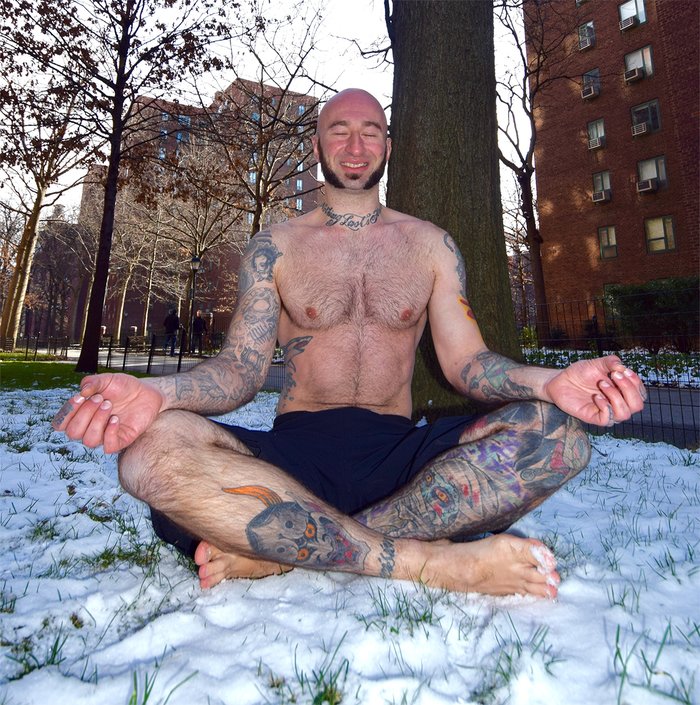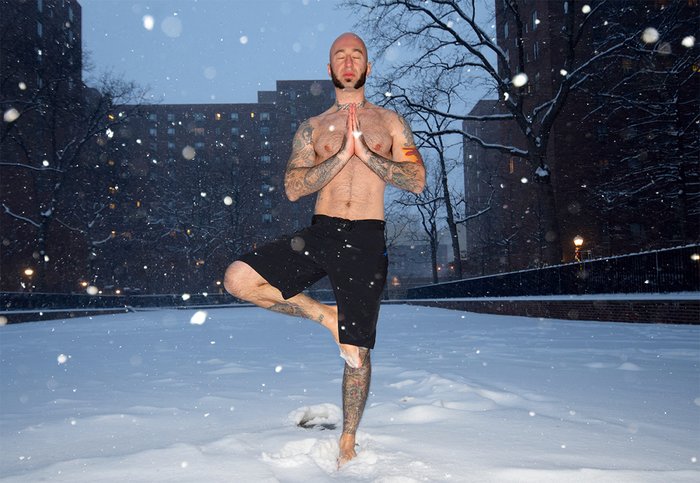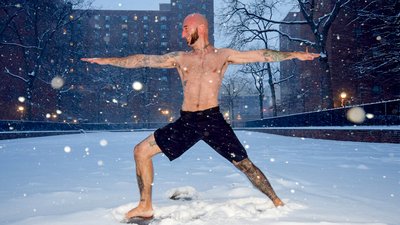Some of my earliest childhood memories are of playing in the snow. My mother would insist that I wear a coat, gloves, and a hat, but I'm pretty sure I was ready to just dive in naked. After some resistance, I'd eventually bundle up as per Mom's orders, run into the yard, and roll around in the snow. Never once did I think about the temperature. I was having too much fun!
As an adult, I've continued to enjoy spending time outdoors doing physical activities, regardless of the weather. In fact, I've built my career around my passion for practicing calisthenics anytime, anywhere. I've also maintained my love for playing in fresh snow.
It's only over the last few months, however, that I've begun to see how cold tolerance can be progressively trained the same way as your pecs or biceps. And there are just as many reasons to do so!
The Way of the Iceman
Like many people in the world of fitness, I've really had my eyes opened by the teachings of Dutch cold-exposure expert Wim "The Iceman" Hof. He's spoken to the importance of cold exposure on many podcasts and in several books, including his recent release, "The Way of the Iceman."
Hof is far more than just a talking head; he is single-handedly forcing scientists to redefine their understanding of what the human body is capable of through his unbelievable feats of cold-weather endurance. He climbed Mount Everest wearing only shorts and shoes, and he ran a half-marathon barefoot above the Arctic Circle in Finland. Hof and his subjects have been studied in a university setting, where it appeared that their combination of meditation and cold exposure actually boosted their immune systems.[1]
Of course, that's just one case study, and this topic definitely hasn't been comprehensively studied yet. But anecdotally, I can say that cold training provides immediate physical effects, such as a tremendous and lasting surge of energy. As the devotees of cold showers will tell you, it also helps to steel the mind, build overall resolve, and simply help ready you to face whatever the natural world—or your professional or personal worlds—can throw at you.
So, why aren't more people out there in the snow? For the same reason they don't exercise: We live in a culture that encourages comfort above all else. Just as children are often discouraged from physical activity—don't climb on those monkey bars, or you might get hurt!—we are also steered away from experiencing the elements. Over time, our willingness to change shrinks, and it just becomes more daunting to start.
The biggest hurdle is, and has always been, your mindset. I'm sure you have a friend or two who thinks that you're crazy for working out at all. Keep that in mind if you start to think I'm crazy for working out bare-chested in the cold.
Where to Start With Cold Exposure
Of course, you shouldn't just jump into a shirtless workout in the freezing snow if you haven't been outside without a coat in 20 years. Just as it would be ill-advised to attempt a 300-pound deadlift on your first day of strength training, you should gradually ease your body into experiencing the cold.

I'm still a relative beginner at this, but I've already made a lot of progress in just a few months by using the following three techniques:
1. Cold Showers
This is the perfect way to ease your body into experiencing the cold, because your shower is a controlled environment.
Start by taking a normal shower at a comfortable temperature, and then, at the very end, turn the faucet to cold, and stay under the water for as long as you can. It will probably be a shock to your system at first, and you may begin hyperventilating. This is normal. Focus on slowing your breath, and see if you can stay under the water for a full minute.
If you don't make it on the first try, that's fine. I was barely able to do 30 seconds on day one. However, if you commit to doing it every day, you'll likely find yourself able to handle a full minute by the end of your first week. Soon, a minute will no longer be challenging; you can then increase your time to 2 minutes.
After a month or so of consistent training, you should be able to handle 5 minutes or longer without much trouble.
2. Outdoor Cold Exposure
If your local climate is able to bring the cold, then this is an ideal next choice. All you need to do is steel your mind, go outside, and strip down to your shorts. If there is snow around, I encourage you to rub it on your chest and arms.
During your outdoor exposure, you can certainly move around in order to maintain your body heat. Yoga postures and calisthenics exercises like squats, lunges and push-ups are perfect, as they require no equipment and can quickly increase your internal body heat.
You don't have to move, though. You can choose to remain still and simply focus on taking big, deep breaths in order to stoke your inner fire. This is how Hof often recommends building resiliency against the cold. Either way, start with 1 minute, and build your time from there.
3. Ice Baths
The final frontier of cold exposure is the ice bath. I wouldn't recommend trying this one until you are comfortable with the previous two. As the name implies, all you need to do is fill your tub with cold water, then add ice. If you are really hardcore, you can even seek out ice-cold water or cut a hole in a frozen lake and do your ice bath in nature, as Hof himself has become well-known for doing.
No matter how you do it, the idea is for the water to be as close to freezing as possible. Immerse yourself up to your neck, and try to remain calm. Again, focus on using your breath to build heat from inside.
Paying attention to your breath will also calm your mind and take your focus away from the unpleasant sensation of cold water all over your body. Again, start with just 1 minute, then gradually build to longer periods of time.
Don't Forget to Breathe!
All of these techniques are extremely unpleasant at first and require a great deal of mental focus. Hof recommends—and I concur—that you engage in some power breathing prior to cold exposure. This isn't complicated. Simply take 20-50 deep, powerful breaths before entering the cold. Imagine a fire burning deep in your belly as you experience the heat building from within.
The visualization may sound silly—after all, what's an imaginary fire in the face of real-world cold, right? But I'll attest that it works. And when you're out there in the cold, what have you got to lose?
No matter how you prepare, make sure you approach your cold training with reverence and commitment. Just as beginners can hurt themselves by trying too much too soon in the weight room, extended cold exposure can be dangerous if approached carelessly. If you have any health concerns, check with your physician before trying cold training.

Also, keep in mind that hypothermia is real, and you definitely don't want it! Err on the side of safety when experimenting with cold exposure, and be on the lookout for symptoms of hypothermia, including intense shivering, lack of coordination, trouble speaking, confusion, or any loss of consciousness.
Just as patience and consistency with your strength training can make loads that you once considered heavy feel light, gradually building your cold tolerance a little each day can eventually lead to finding bliss in the frozen cold.
Reference
- Kox, M., van Eijk, L. T., Zwaag, J., van den Wildenberg, J., Sweep, F. C. G. J., van der Hoeven, J. G., & Pickkers, P. (2014). Voluntary activation of the sympathetic nervous system and attenuation of the innate immune response in humans. Proceedings of the National Academy of Sciences of the United States of America, 111(20), 7379-7384.

